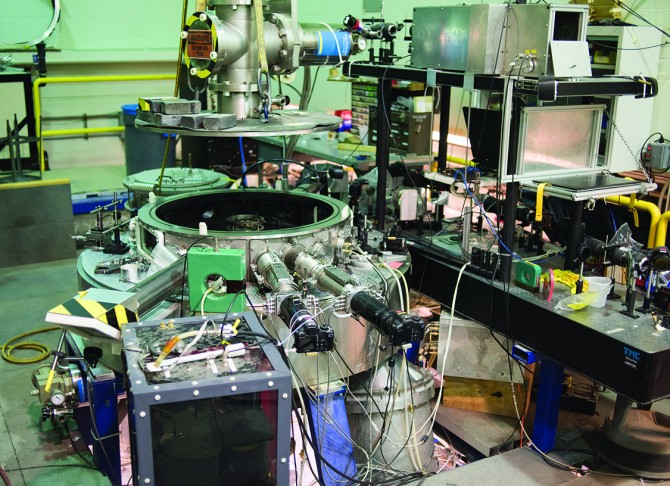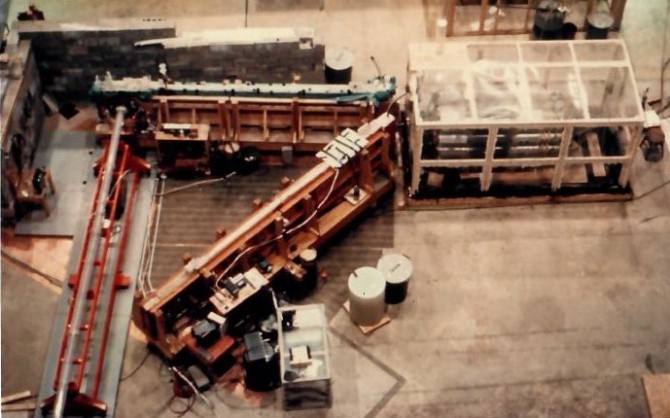Lab of Plasma Studies turns 50, wins $15M grant
By Syl Kacapyr
Cornell’s Laboratory of Plasma Studies (LPS) has much to celebrate as it marks its 50th anniversary with a two-day symposium, Oct. 6-7, and begins another five years of unlocking the secrets of plasma with a $15 million grant from the National Nuclear Security Administration.
Since its inception in 1967, the lab has used powerful bursts of energy to create and study plasma – a state of matter in which atoms are ionized and their electrons become free. Operating in the High Voltage Laboratory on Ithaca’s Mitchell Street before moving into the basement of Upson Hall and then Grumman Hall, LPS was one of the world’s first high-energy-density plasma labs based at a university and has kept Cornell at the forefront of plasma science through the years.
Many of the physicists and engineers who made discoveries there will return to campus for the symposium, which will feature 40 alumni speaking in Clark Hall about how their time at LPS influenced their careers in academia, government and industry.
“We’ve populated the pulse-powered programs of the country more than anyone else,” said David Hammer, LPS co-director and professor of electrical and computer engineering. He was a graduate student when the lab was founded and says most experiments throughout the lab’s history have been centered around technologies that store energy in capacitors and deliver it quickly through powerful pulses of current.
“These machines have been used to extract a number of directed energy sources from plasma. It started out with electron beams when the lab was founded, then it became microwave generation, and then ion beams. Now, Z-pinches make up a large percentage of our work,” said Hammer.
Bruce Kusse, LPS co-director and professor of applied and engineering physics, joined the lab as a research associate shortly after it was founded and still remembers its first machine, scrapped together by researchers for electron beam extraction.
“It was made partially with plywood, epoxy and plastic,” said Kusse, noting that being on the forefront of plasma science means LPS has always had to customize its equipment.
Today, the lab boasts its own machine shop; researchers produce parts they need for two world-class, pulsed-power machines and state-of-the-art diagnostic tools. Both machines produce energy pulses lasting 100 to 200 nanoseconds, one at a half-million amperes and the other at 1 million amperes. The machines produce Z-pinches, in which electric currents produce a magnetic field that compresses the plasma, giving it new properties that scientists are still working to fully comprehend.
“Out of this plasma come very intense X-ray bursts. The only way to make a more intense burst is with a bigger pulsed-power machine, a laser system that costs 10 to 100 times as much as ours, or with a nuclear explosion,” said Kusse. “The other thing that happens in our experiments is the creation of conditions approaching those required for inertial fusion.”
A major contribution of LPS to science has been diagnostic tools it’s developed to characterize high-energy-density plasma, which is highly unstable. “There’s myriad instabilities that are studied with these diagnostics, helping us to understand the physics behind these instabilities and how you can mitigate them,” said Kusse.
Scientists hope that a better understanding of the fundamental physics underlying plasma, X-ray busts and inertial fusion conditions will eventually lead to the holy grail of energy research: a controlled fusion system that produces nuclear reactions similar to those happening at the center of the sun, but safely harnesses the reactions for energy production.
It’s one of the concepts that has driven LPS research since its beginning, one researchers will continue to explore thanks to a $15 million, five-year grant taking effect Oct. 1. The funding enables LPS’s Multi-University Center of Excellence for Pulsed-Power-Driven High-Energy-Density Science to advance its research program in collaboration with scientists from the University of California, San Diego, Imperial College (London), the Lebedev Physical Institute (Moscow), the University of Michigan, Princeton University and the Weizmann Institute of Science (Israel).
This collaborative approach to experimental, theoretical and computational high-energy-density plasma research has been at the heart of LPS for 50 years.
“Having theorists and experimentalists working together to achieve the end point of a project, it’s worked out very well for the lab,” said Hammer.
Syl Kacapyr is public relations and content manager for the College of Engineering.
Media Contact
Get Cornell news delivered right to your inbox.
Subscribe
